Class 9 Maths Karnataka Model Papers Set 5 With Solutions
Choose the correct alternative and Write the complete answer along with its alphabet in the sheet provided:
Question 1. Recurring decimal 0.68686868……is also represented as
- \(0. \overline{6}\)
- \(\overline{0.68}\)
- \(\overline{0.68}\)
- \(0.6 \overline{8}\)
Solution: 3. \(\overline{0.68}\)
Question 2. An example of a rational number is
- 4.795831
- 0.3796
- 1.1012001…..
- 0.6868…..
Solution: 2. 0.3796
Karnataka 9th Standard Maths Model Paper 2023 Set 5 Free PDF with Answer Key
Question 3. The expansion form of(a + b)2 is
- a2+2ab +b2
- a2-2ab + b2
- a2 – 2ab – b2
- a2 +ab + b2
Solution: 1. a2+2ab +b2
Question 5. If a ray stands on a line, then the sum of two adjacent angles is
- 60°
- 180°
- 360°
- 90°
Solution: 2. 180°
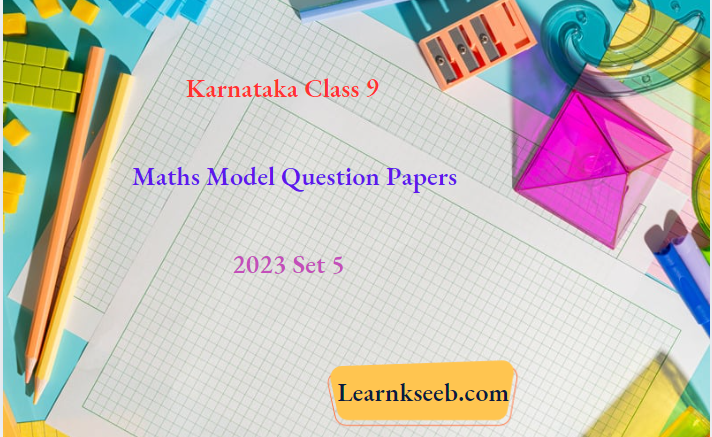
Question 5. In the fig, APAB is congruent to
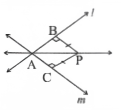
- △PAC
- ∠PAC
- ∠PAB
- △PAB
Solution: 1. △PAC
Question 6.Write any two solutions for x + 4y = 0
Solution:
x + 4y = 0
4 y = -x
y = -x/4
when x = 0, y = 0 (0, 0)
∴ Two solutions are when x=l, y = -1/4 (0, -1/4 ) (0,0)(0, -1/4)
Question 7. In the fig, AB AC then
- OB =___________
- AO bisects_________
Solution:

- OB = OC
- AO bisects ∠A
Question 8. Write any two properties of a rhombus.
Solution:
- The sides of a rhombus are equal.
- The diagonals bisect each other at right angles.
Answer the following:
Question 1. Represent \(\sqrt{5}\) on the number line.
Solution:

Question 2.Express \(0.4 \overline{7}\) in the form of p/q where p and q interfere and q ≠ 0
Solution:
Let x = 0.477……………..
10x = 4.7777……………
⇒10x = 4.3 + 0.4777….
⇒10x = 4.3 + x
⇒ l0x-x = 4.3
⇒ 9x = 4.3
⇒x = 4.3/9 = 43/90
Thus, \(0.4 \overline{7}=\frac{43}{90}\)
Question 3.use the factor theorem to determine whether g(x) = x +1 is a factor of p(x) = 2x3+x2– 2x -1
Solution:
If g(x) =x + 1 is a factor of the given polynomial p(x), then p(-1) must be zero.
P(x) = 2x3+x2+(-1)2– 2 (-1) -1
P(-1) = 0
Hence g(x) =x+ 1 is a factor of the given polynomial.
Class 9 Karnataka Maths Model Paper 2023 Set 5 Solved Questions PDF
Question 4. Evaluate 95 x 96 using the suitable identity.
Solution:
95 x 96 = (100 – 5) (100 -4)
(x+ a) (x + b) = x2 + (a + b)x + ab
=(100)2+ { (-5) + (-4) } 100 + (-5) (-4)
= 10000 – 900 + 20
= 9120
Question 5. Take any three consecutive even numbers and find their product: for example, 2 x 41 6 = 48,4x6x8 = 192 and so on. Make two conjectures about these products.
Solution:
Three possible conjectures are:
- The product of any three consecutive even nos. is even.
- The product of any three consecutive even numbers is divisible by 4.
Question 6. Restate the following statements with appropriate conditions, so that they become true statements.
- All prime numbers are odd.
- Two times a real number is always even.
- For any x, 3x +1 > 4
- For any x, x3≥0
Solution:
- All prime numbers greater than 2 are odd.
- Two times a natural number is always even.
- For any x > 1, 3x + 1 > 4
- For any x > 0, x3 > 0
Question 7. ABCD is a cyclic quadrilateral whose diagonals intersect at point E. If ∠DBC = 70°, ∠BAC = 30° find ∠BCD.
Solution:
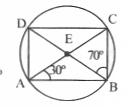
∠BAC = ∠BDC
[∵ angles in the same D. segment]
∴∠BAC = ∠BDC =30°
In ABCD,
∠BDC +∠DBC +∠BCD = 180°
30° +70° + ∠BCD = 180°
∠BCD = 180° – 100°
∴∠BCD =80°
Question 8. Diagonals AC and BD of an A trapezium ABCD with AB || DC intersect each other at O. Prove that ar (△AOD) = ar (△BOC)
Solution: △DAC and △DBC lie on the same base DC and between the same parallels AB and CD.
∴ Area ( △DAC) = Area (△DBC )
Area (△DAC) – Area (△DOC) = Area (△DBC)-ar△DOC
∴ Area (△AOD)= Area (△BOC)
Question 9. Represent the following data with a bar graph
Political party Seats won.

Solution:
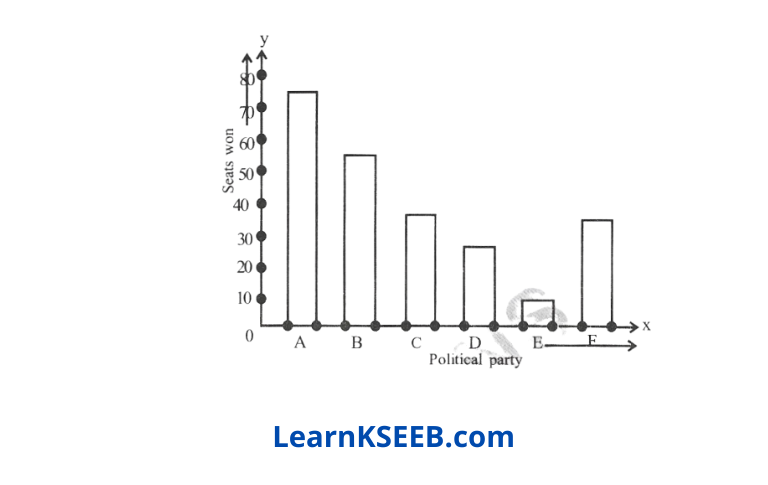
Question 10. A river 3m deep and 40m wide is flowing at the rate of 2km per hour. How much water will fall into the sea in a minute?
Solution:
The breadth of the river = 40m
Depth of the river = 3 m
flowing speed of the river per hour = 2km
or length per minute of the river = 2000/60 m
∴ water flowing per minute
\(=\frac{2000}{6 \emptyset} \times{ }^2-4 \emptyset \times \not^1\)=4000m3
Question 11. ABC is an isosceles triangle in which altitudes BE and CF are drawn to equal sides AC and AB respectively. S.T. these altitudes are equal.
Solution:
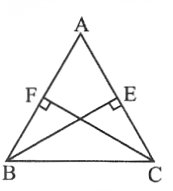
In △AEB and △AFC
∠AEB =∠AFC (each 90°)
∠A = ∠A (common)
AB = AC (given)
∴ △AEB = △AFC (AAA congruence rule)
∴ BE = CF(CPCT)
Karnataka Board 9th Maths Model Paper 2023 Set 5 Latest Exam Pattern
Question 12. Give a possible expression for the length and breadth of the rectangle whose area is 25a2-35a+ 12
Solution:
Area of the rectangle = length x breadth
25a2 – -35a + 12 *= length x breadth
25a2 -15a – 20a +12 = length x breadth
5a(5a – 3) – 4(5a – 3) = length x breadth
(5a – 3) (5a – 4) = length x breadth
∴ length = (5a – 3)
breadth = (5a – 4)
Solved Karnataka Class 9 Maths Papers Set 5
Question 13. Find the area of a triangle two sides of which are 18cm and 10cm and the perimeter is 42cm.
Solution:
Let a, b and c be the sides of the triangle.
∴ a = 18cm, b = 10cm and c = x
∴a + b + c=18+ 10+ x
42 — 28 + x
x = 42 – 28
x = 14cm
S = perimeter/2
S = 42/2
S = 21cm
Area of a triangle = \( \sqrt{s(s-a)(s-b)(s-c)}\)
\(=\sqrt{21(21-18)(21-10)(21-14)}\) \(\begin{aligned}& =\sqrt{21 \times 3 \times 11 \times 7} \\
& =\sqrt{21 \times 21 \times 11} \\
& =\sqrt{(21)^2 \times 11} \\
& =21 \sqrt{11} \mathrm{~cm}^2
\end{aligned}\)
Question 14.Write four solutions for 2x + y = 7
Solution:
2x + y – 7
⇒ y = 7-2x
when x = 0, 2 (0) + y = 7
0 + y = 7
y =7
x = 1, 2(1) + y = 7
2 + y = 7
y = 7-2
y=5
x = 2, 2(2)+y =7
6 + y = 7
y = 7- 6
y= 1
x = 3, 2 (3) + y = 7
6 + y = 7
y = 7 – 6
y=1
∴ four solutions are (0, 7) (1, 5) (2,3) (3,1)
Question 15. In the fig, if AB || DE, ∠BAC = 35° and ∠CDE-53°, find ∠DCE.
Solution:
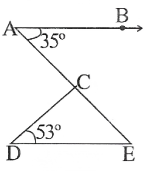
In the fig AB || DE
BAC = 35° and CDE = 530
∴ ∠BAE = ∠DEC (altemater angles)
∴ ∠DEC = 35°
In ADCE,
∠DCE + ∠CDE + ∠DEC = 180°
∠DCE + 53° +35° = 180°
∠DCE =180°—88°
∠DCE = 92°
Question 16. ABCD is a trapezium in which AB || DC, BD is a diagonal and E is the mid-point of AD. A line is drawn through E parallel to AB intersecting BC at F. S.T. F is the midpoint of BC.
Solution:
Let EF intersect BD and G
In △ABD,
E is the midpoint of
AD and EF || AB.
∴ G is the midpoint of BD
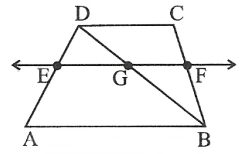
[∵ converse of the midpoint of theorem]
DC || AB and EF || AB
DC || EF
In △BDC
GF || DC and G is the midpoint of BD
∴ ‘F’ is the midpoint of BC [By converse of midpoint theorem]
Question 17. If two circles intersect at two points, prove that their centres lie on the perpendicular bisector of the common chord.
Solution:
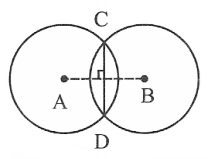 Two circles with centres A and B intersect at C and D to join CD.
Two circles with centres A and B intersect at C and D to join CD.
CD is the chord to a circle with centre ‘A’.
∴ The perpendicular bisector drawn from the centre ‘O’ of a chord passes through the centre ‘B’ of the circle. Similarly, Cd is also the chord to the circle with centre B.
∴ The perpendicular bisector drawn from the centre ‘O’ of the chord passes the centre B of the circle.
∴ centres of the circles lie on the perpendicular bisector of the common chord.
9th Standard Karnataka Maths Sample Paper 2023 Set 5 Important Questions
Question 18. △ABC and △DBG are two isosceles triangles on the same base BC. S.T.
∠ABD = ∠ACD A
Solution: In △ABC , AB = AC (given)
∴ ∠ABC = ∠ACB.-(1)
[Angles opp. to equal sides are equal]
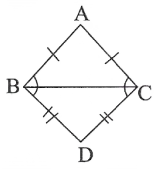
In ADBC,
DB = DC (given)
∴ ∠DBC = ∠DCB……..(2) [Angles opposite to equal sides are equal]
By adding (1) and (2)
∠ABC + ∠DBC = ∠ACB + ∠DCB
∴ ∠ABD = ∠ACD
Answer the following:
Question 1. In △ABC and △DEF, AB = DE, AB || DE,
BC = EF and BC || EF. Vertices A, B and C are joined to vertices D, E and F respectively S. T.
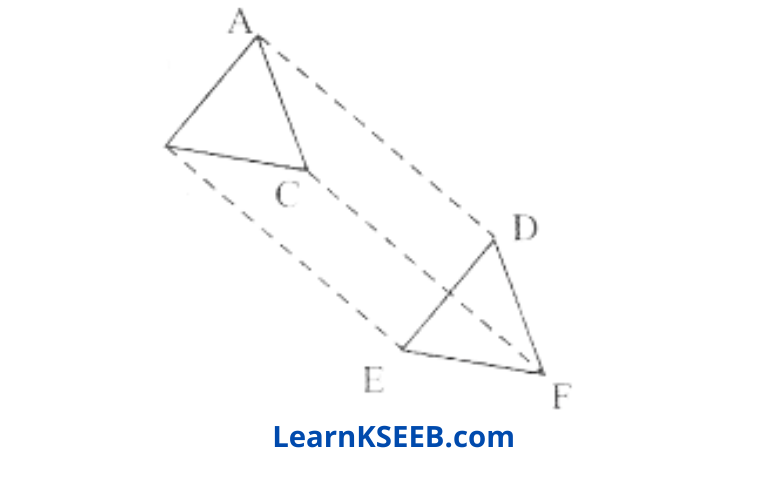
- Quadrilateral ABED is a parallelogram B
- Quadrilateral BEFC A is a parallelogram
- AD || CF and AD = CF
Solution:
- AB = DE [Given]
AB || DE [Given]
If two opposite sides of a quadrilateral are equal and parallel to each other. Then it will be a parallelogram
∴ Quadrilateral ABED is a parallelogram. - Again BC = EF and BC || EF
∴ Quadrilateral BCEF is a parallelogram. - As we know that ABED and BEFC are parallelograms
∴ AD = BE and AD || BE
and BE = CF and BE || CF
∴ AD = CF and AD || CF
Question 2. XY is a line parallel to the side BC of a triangle ABC. If BE || AC and CF 11 AB meet XY at E and F respectively, S.T. ar(ABE) = ar (ACE)
Solution:
XY || BC(given)
and CF||BX (∵ CF || AB(given))
∴ BCFX is a ||gm
(a quadrilateral is a ||gm if its opposite sides are ||le) A
∴ BC=XF (opposite sides of ||gmare equal)
⇒ BC-XY+YF……….. (1)
again XY || BC (given)
and BE || CY(∵ BE || AC)
∴ BCYE is a ||gm
(A quadrilateral is a ||gm if its opposite sides are ||gm)
∴ BC=YE (opp. sides of a ||gm are equal)
⇒ BC=XY+XE…………… (2)
from (1) and (2)
XY+YF = XY+XE
⇒ YF = XE
XE = YF
∴ △AEX and △AFY have equal bases
(∵ XE=YF) on the same line, EF and have a common vertex A.
∴ Their altitudes are also the same.
∴ ar(△AEX)=ar(△AFY)…………. (4)
△BEX and △CFY have equal bases (XE=YF) on the same line, EF and are between the same ||les
EF and BC (∵ XY||BC)
ar(△BEX)=ar(△CFY)………….(5)
Two Triangles on the same base (equal and between the same parallels are equal in the area)
Adding the corresponding sides of(4) and (5) we get
ar(△EX)+ar(△BEX) = ar(△AFY)+ar(△CFY)
∴ ar(△ABE)=ar(△ACF)
Question 3. In a city, the weekly observations made in a study on the cost of a living index are given in the following table.


Draw a frequency polygon for the above data.
Solution:
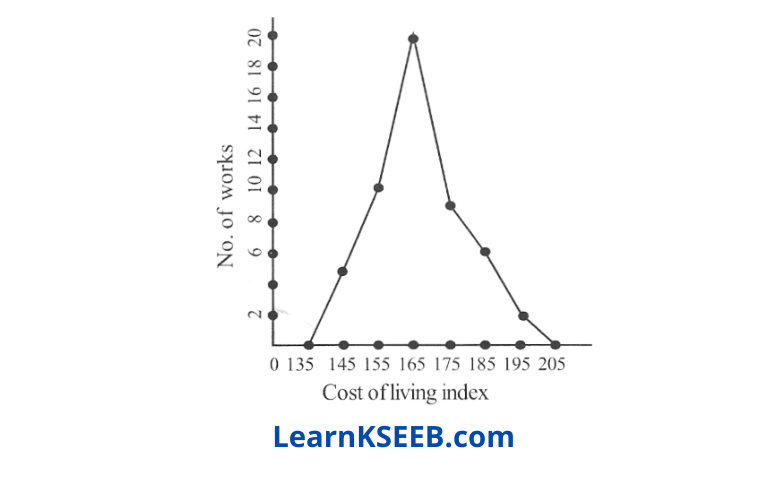
Karnataka Board 9th Class Maths Model Question Paper 2023 Set 5 with Answer Key
Question 4. Construct a triangle PQR in which QR =6cm, ∠Q = 60° and PR – PQ = 2cm.
Solution:
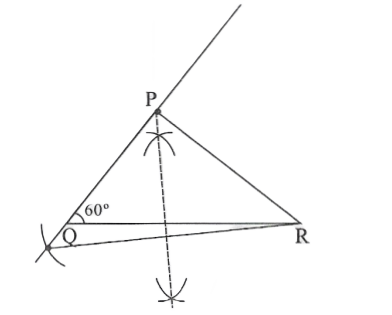
Question 5. S.T. a median of a triangle divides it into two triangles of equal areas.
Solution: Let ABC be a triangle and AD be one of its medians
ar (△ABD) = 1/2 x base x altitude
=1/2 x BD x AN
= 1/2 x CD x AN (BD = CD)
= 1/2 x base x altitude(of △ACD)
ar(△ABD) = ar(△ACD)
Question 6.Represent 2.665 on the number line
Solution:
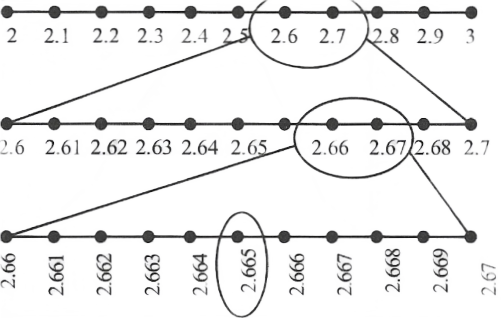
Answer the following:
Question 1. Draw the graph 5x + y = 8
Solution:
Scale: x-axis ; 1cm = limit y-axis ; 1cm= 1unit
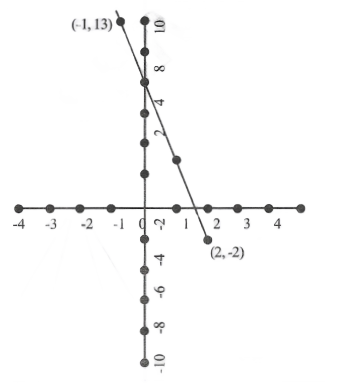
Karnataka 9th Maths Sample Paper 2023 Set 5 for Board Exam Preparation
Question 2. Two parallel lines % and m are intersected by a transversal P. Show that the quadrilateral formed by the bisectors of interior angles is a rectangle
Solution: PS || QR and transversal p intersect them at points A and C respectively.
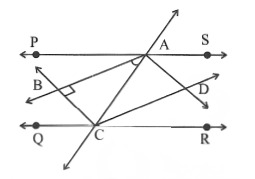
The bisectors of ∠PAC and ∠ACQ intersect at B and bisectors of ∠ACR and ∠SAC intersect at D.
Now, ∠PAC = ∠ACR
∴ 1/2 ∠PAC = 1/2 ∠ACR
∠BAC = ∠ACD
Alternate angles
∴ AB || DC
Similarly, BC || AD
∴ quadrilateral ABCD is a parallelogram
∠PAC + ∠CAS = 180° (linear pair)
1/2 ∠PAC +1/2 ∠CAS = 1/2 x180°
∠BAC + ∠CAD = 90°
∠BAD = 90°
So, ABCD is a parallelogram in which one angle is 90°
∴ ABCD is a rectangle.
Question 3. There is a slide in the park. One of its side walls has been painted in some colour with a message “keep the park green and clean”. If the sides of the wall are 15m, 11m and 6 m, find the area painted in colour.
Solution: The side is in the form of a triangle.
Let the sides be a = 15m, b= 11m, c = 6m
∴ \(\mathrm{S}=\frac{\mathrm{a}+\mathrm{b}+\mathrm{c}}{2}\)
\(\mathrm{S}=\frac{15+11+6}{2}\) \(S=\frac{32}{2}\)S = 16m
Area of the triangular area =
\(\sqrt{s(s-a)(s-b)(s-c)}\) \(\begin{aligned}& =\sqrt{16(16-15)(16-11)(16-6)} \\
& =\sqrt{16 \times 1 \times 5 \times 10} \\
& =20 \sqrt{2} \mathrm{~m}^2
\end{aligned}\)
Karnataka State Board Class 9 Maths Model Paper 2023 Set 5 with Step-by-Step Solutions
Question 4. Find the capacity in litres of a conical vessel with
- Radius 7cm, slant height 25cm
- Height 12cm, slant height 13cm.
Solution:
1. Radius 7cm (r) slant height 25cm(l)
\(\mathrm{h}=\sqrt{\ell^2-\mathrm{r}^2}=\sqrt{25^2=7^2}=24 \mathrm{~cm}\)The volume of the conical vessel = \(\frac{1}{3} \pi r^2 h\)
\(=\frac{1}{\not \beta} \times \frac{22}{\not x} \times 7 \times 7 \times 24^8\)= 1232cm3
∴ The capacity of the vessel in litres = 1232/1000
= 1.232 litres
2. h= 12cm, l = 13cm
∴ \(\mathrm{r}=\sqrt{\ell^2-\mathrm{h}^2}\)
\(\begin{aligned}& r=\sqrt{13^2-12^2} \\
& r=\sqrt{169-144} \\
& r=\sqrt{25} \\
& r=5 \mathrm{~cm}
\end{aligned}\)
volume of the conical vessel =\(\frac{1}{3} \pi r^2 h\)
\(=\frac{1}{\not p} \times \frac{22}{7} \times 5 \times 5 \times 12^4\) \(=\frac{22 \times 25 \times 4}{7}\)=2200/7
= 314.28cm3
∴The capacity of the vessel in litres =314.285/1000
= 0.314281itres
